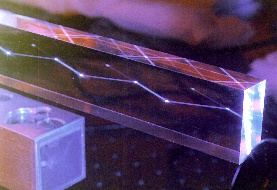Recent Research Projects
|
From 1995 until 2008 I worked as physicist and staff research software developer at the SLAC National Accelerator Laboratory in the beautiful San Francisco Bay Area. After getting my Ph.D. in particle physics at Bonn University, Germany, I came to SLAC in October 1995 with a Feodor Lynen fellowship (from Oct. 95 through Sep. 98) from the Alexander-von-Humboldt foundation. I spent most of my time at SLAC working on the DIRC (Detection of Internally Reflected Cherenkov light), a new type of the particle identification detector, used for the first time in the BaBar experiment.
In the first couple of years I concentrated on fundamental issues such
as the optical properties and radiation hardness of the synthetic fused
silica radiators for this new type of Ring Imaging Cherenkov device.
This R&D work for the DIRC has been documented in many
internal notes and publications in
peer-reviewed journals.
In 1998, the focus shifted to the construction of the DIRC where I
led the work on optical quality control as well as studies of
the long-term behaviour of the optics of radiator bars.
After the start of DIRC data taking in the winter 1998/99 I coordinated
the analysis of DIRC detector data with the goal of understanding the
resolution and backgrounds as DIRC detector analysis manager.
I was
DIRC commissioner and operations manager from 1999-2001 and in 2008
and have given
many talks about the BaBar-DIRC. |



|
|
After the successful start of the BaBar DIRC system I worked on the detector R&D toward the development of a Focusing DIRC, a next-generation particle identification system for future experiments. The goal was to improve the DIRC detector concept by making it less sensitive to accelerator induced background (expected to limit the DIRC particle identification performance at very high luminosities) and add very fast timing of the Cherenkov photon hit time which allows a correction of the chromatic dispersion of the Cherenkov angle. The effort resulted in a design in which the water-filled standoff region (the primary source of background in the BaBar DIRC) was relaced by a compact oil tank. A focusing mirror imaged the photons on an array of fast photo detectors which provided single photon timing at the 100ps level. The design was validated in a prototype in particle beams at SLAC where the Focusing DIRC prototype proved to be the first RICH detector to successfully correct the chromatic dispersion of the Cherenkov angle using fast timing. This fast focusing DIRC design inspired the subsequent FDIRC proposal for the SuperB experiment in Italy as well as the next-generation DIRC detectors for the Belle II experiment at KEK and the PANDA experiment at FAIR. In addition to the detector physics activities I contributed to the physics analysis of BaBar data, in particular the production of charged hadrons in B decays, and the analysis of SLD data with a focus on QCD and fragmentation studies.
My computing responsibilities included system management on RedHat
linux and Windows XP/Vista as a
mega czar and desktop computing support for experimental group B.
I was a SLAC
Web Support Coordinator and the webmaster for
experimental group B,
the
DIRC,
the
ICFA Instrumentation Bulletin.
Other past web projects include the
SLAC Graduate Student Program and the
SLAC Summer Institute.
|
|
